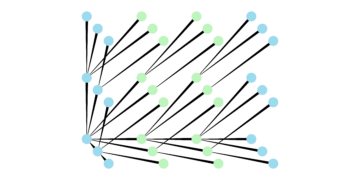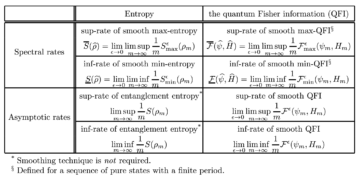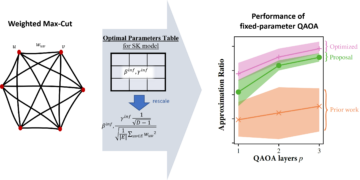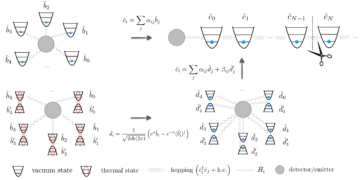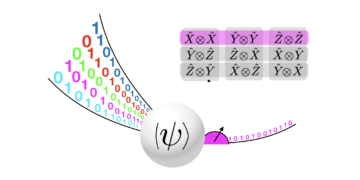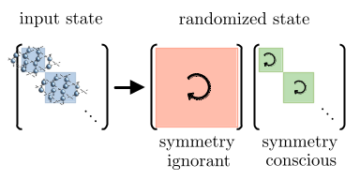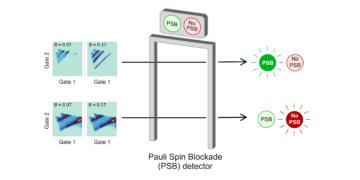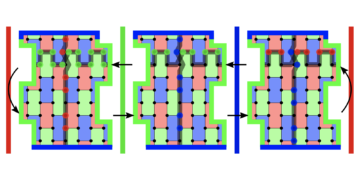Leibniz Universität Hannover, Appelstraße 2, 30167 Hannover, Germany
Find this paper interesting or want to discuss? Scite or leave a comment on SciRate.
Abstract
I show that if a finite-dimensional density matrix has strictly smaller von Neumann entropy than a second one of the same dimension (and the rank is not bigger), then sufficiently (but finitely) many tensor-copies of the first density matrix majorize a density matrix whose single-body marginals are all exactly equal to the second density matrix. This implies an affirmative solution of the exact catalytic entropy conjecture (CEC) introduced by Boes et al. [PRL 122, 210402 (2019)]. Both the Lemma and the solution to the CEC transfer to the classical setting of finite-dimensional probability vectors (with permutations of entries instead of unitary transformations for the CEC).
Featured image: Three conditions on a pair of finite-dimensional density matrices $(rho,rho’)$ are equivalent. Top: Entropy is strictly increasing and rank non-decreasing. Middle: There exists a finite-dimensional auxiliary system in state $sigma$ and a joint-unitary $U$ such that the transformed state $Urhootimes sigma U^dagger$ has reduced density matrices $rho’$ and $sigma$. This provides a single-shot characterization of entropy. Bottom: There exists a finite number $n$ such that $n$ copies of $rho$ majorize a state whose marginals all exactly coincide with $rho’$.
Popular summary
In the paper, a conjecture is solved in the affirmative which implies that one can think of entropy without an asymptotic limit. Instead it is asked when it is the case that a system’s statistical state (density matrix) can be transformed to a different one using unitary dynamics if one has access to a finite auxiliary system whose statistical state must not change in the process. The auxiliary system is refereed to as catalyst, as it enables state-transitions otherwise impossible while not changing its own state. The results of the paper show that a system’s state can be transformed from one state to another using a suitable catalyst if and only if the entropy increases (and the rank of the density matrix does not decrease).
► BibTeX data
► References
[1] Paul Boes, Jens Eisert, Rodrigo Gallego, Markus P. Müller, and Henrik Wilming. “Von neumann entropy from unitarity”. Physical Review Letters 122, 210402 (2019).
https://doi.org/10.1103/physrevlett.122.210402
[2] H. Wilming. “Entropy and reversible catalysis”. Physical Review Letters 127, 260402 (2021).
https://doi.org/10.1103/physrevlett.127.260402
[3] Runyao Duan, Yuan Feng, Xin Li, and Mingsheng Ying. “Multiple-copy entanglement transformation and entanglement catalysis”. Phys. Rev. A 71, 042319 (2005).
https://doi.org/10.1103/PhysRevA.71.042319
[4] Yuan Feng, Runyao Duan, and Mingsheng Ying. “Relation between catalyst-assisted transformation and multiple-copy transformation for bipartite pure states”. Physical Review A 74, 042312 (2006).
https://doi.org/10.1103/physreva.74.042312
[5] Naoto Shiraishi and Takahiro Sagawa. “Quantum thermodynamics of correlated-catalytic state conversion at small scale”. Physical Review Letters 126, 150502 (2021).
https://doi.org/10.1103/physrevlett.126.150502
[6] Rajendra Bhatia. “Matrix analysis”. Springer New York. (1997).
https://doi.org/10.1007/978-1-4612-0653-8
[7] Albert W. Marshall, Ingram. Olkin, and Barry C. Arnold. “Inequalities : theory of majorization and its applications”. Springer Science+Business Media, LLC. (2011).
https://doi.org/10.1007/978-0-387-68276-1
[8] Markus P. Müller. “Correlating thermal machines and the second law at the nanoscale”. Physical Review X 8, 041051 (2018).
https://doi.org/10.1103/physrevx.8.041051
[9] Tulja Varun Kondra, Chandan Datta, and Alexander Streltsov. “Catalytic transformations of pure entangled states”. Physical Review Letters 127, 150503 (2021).
https://doi.org/10.1103/physrevlett.127.150503
[10] Patryk Lipka-Bartosik and Paul Skrzypczyk. “Catalytic quantum teleportation”. Physical Review Letters 127, 080502 (2021).
https://doi.org/10.1103/physrevlett.127.080502
[11] Roberto Rubboli and Marco Tomamichel. “Fundamental limits on correlated catalytic state transformations”. Physical Review Letters 129, 120506 (2022).
https://doi.org/10.1103/physrevlett.129.120506
[12] Soorya Rethinasamy and Mark M. Wilde. “Relative entropy and catalytic relative majorization”. Physical Review Research 2, 033455 (2020).
https://doi.org/10.1103/physrevresearch.2.033455
[13] Paul Boes, Nelly H.Y. Ng, and Henrik Wilming. “Variance of relative surprisal as single-shot quantifier”. PRX Quantum 3, 010325 (2022).
https://doi.org/10.1103/prxquantum.3.010325
[14] Vjosa Blakaj and Michael M. Wolf. “Transcendental properties of entropy-constrained sets” (2021). arXiv:2111.10363.
arXiv:2111.10363
[15] R. Renner. “Security of Quantum Key Distribution”. PhD thesis. ETH Zurich. (2005).
[16] Marco Tomamichel. “Quantum information processing with finite resources”. Springer International Publishing. (2016).
https://doi.org/10.1007/978-3-319-21891-5
[17] T Holenstein and R Renner. “On the randomness of independent experiments”. IEEE Transactions on Information Theory 57, 1865–1871 (2011).
https://doi.org/10.1109/tit.2011.2110230
[18] Noah Linden, Milán Mosonyi, and Andreas Winter. “The structure of rényi entropic inequalities”. Proceedings of the Royal Society A: Mathematical, Physical and Engineering Sciences 469, 20120737 (2013).
https://doi.org/10.1098/rspa.2012.0737
Cited by
Could not fetch Crossref cited-by data during last attempt 2022-11-10 16:28:43: Could not fetch cited-by data for 10.22331/q-2022-11-10-858 from Crossref. This is normal if the DOI was registered recently. On SAO/NASA ADS no data on citing works was found (last attempt 2022-11-10 16:28:44).
This Paper is published in Quantum under the Creative Commons Attribution 4.0 International (CC BY 4.0) license. Copyright remains with the original copyright holders such as the authors or their institutions.


